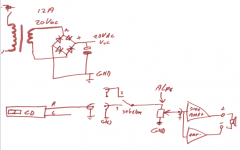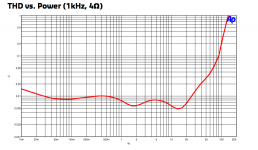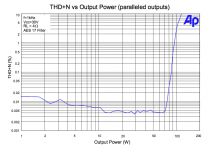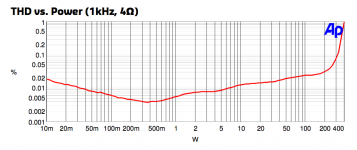I am a bit curious about that TK2050... hmm, maybe I have to test it?
About the comparison between UcD180 and TK2050, was that with the UcD180ST or HG ?
The UCD180st with LME49720 no NE5532.
I hope StigEric it doesn't bother I am writing about the tripad amp in this topic.
After some improvements concerning cooling on the Sure design because the original way of mounting is very sensitive to failure. All chips have to be mounted flat at the same hight and the heatsink has to be placed flat to ensure cooling.
It is a faulty construction. I use Bergquist Sil-Pad Products ~ Thermal Materials, Thermal Solutions ~ The Bergquist CompanySilpad to transfer heat to the heatsink. It is soft and 1mm thick to fill any uneven surface.
An externally hosted image should be here but it was not working when we last tested it.
Donor for the project is my first build end stage from the mid 80's. It survived many crashes and experiments. Man was I nerves when buying that toroidal transformer I had to save long to get to money together and was afraid I maybe choose the wrong type back then .

Test board 24step volume control 10Klog. 30000uF capasitors and Sure wiring and amp.


About the sound there is a difference between the UCD180 and the TK2050 the TK2050 sounds a bit more open then the UCD. And the TK2050 seems to accentuate the high detail.
I had read andrea's artikel2008 - Class D Amplifier comparasion test about class-d amp and the TK2050 sounded a bit metal like and I can't help also to describe it that way guitar strings get a bit metal string sound voices are bright. I personally like bright sound. So there for I prever the sure sound both amps perform very well but do have a differend sound what HF-range concerns.
When we look at the price four ucd modules cost 300euro and the Sure amp witch I for now prefer sound wise only 41 euro. And the sure also has a heatsink that we have to buy for the UCD. So same class performance both amps perform good and the sure for 1/7 of the price of UCD. Hypex has to do something about the price IMO.
This looks like it would be good for my daughter, any chance of a quick schematic for a knuckle head electronics beginner😀
I like your approach, never throw anything away, that's my moto.
David
About the sound there is a difference between the UCD180 and the TK2050 the TK2050 sounds a bit more open then the UCD. And the TK2050 seems to accentuate the high detail.
How much of that is actually due to the amp? How much is due to the output filter's dependence on the speaker impedance?
Most output filters in class D amps seem to be designed for a certain (resistive) load. For optimum results it takes different filters for different load impedances and a linearised speaker impedance.
This looks like it would be good for my daughter, any chance of a quick schematic for a knuckle head electronics beginner😀
I like your approach, never throw anything away, that's my moto.
David
Hi david,
This board contains four 100W amplifiers you can parallel inputs make stereo left 100+100 and right 100+100.
Or use it as a surround amplifier. 4X100W then you need a quad potentiometer not stereo. This one is with motor

you need a 6 step input selector that would be the cable I have in my fingers. The wiper of that one is connected to the 10kOhm logarithmic potentiometer ( I would buy a alps).
Then the wiper of the potentiometer is connected to the input cinch of the sure board.
The sure board has a VCC = +28V and a GND = 0V gnd. There for you need a transformer with 20V ac output 12A. And use 3x 10000uF 40V capacitors or 6X 4700uf 40V. And a rectifier bridge 25A.
Grey Srew terminals are the loudspeaker outputs. Sure kit also contains banana terminals black and red witch I use on the photo.
Attachments
-
 Schermafbeelding 2011-02-13 om 12.25.45.jpg48.1 KB · Views: 683
Schermafbeelding 2011-02-13 om 12.25.45.jpg48.1 KB · Views: 683 -
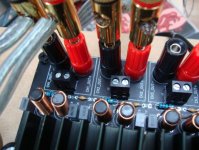 Schermafbeelding 2011-02-13 om 12.25.10.jpg70 KB · Views: 671
Schermafbeelding 2011-02-13 om 12.25.10.jpg70 KB · Views: 671 -
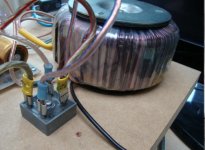 Schermafbeelding 2011-02-13 om 12.24.44.jpg51.5 KB · Views: 689
Schermafbeelding 2011-02-13 om 12.24.44.jpg51.5 KB · Views: 689 -
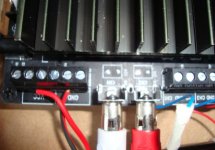 Schermafbeelding 2011-02-13 om 12.24.22.jpg47.9 KB · Views: 691
Schermafbeelding 2011-02-13 om 12.24.22.jpg47.9 KB · Views: 691 -
 Schermafbeelding 2011-02-13 om 12.24.05.jpg57.6 KB · Views: 685
Schermafbeelding 2011-02-13 om 12.24.05.jpg57.6 KB · Views: 685
Last edited:
How much of that is actually due to the amp? How much is due to the output filter's dependence on the speaker impedance?
Most output filters in class D amps seem to be designed for a certain (resistive) load. For optimum results it takes different filters for different load impedances and a linearised speaker impedance.
Tripad claims low impedance filter due high frequency operation of the digital part. See Data sheet TK2050 http://www.profusionplc.com/images/data%20sheets/tk2050.pdf
Tripad claims low impedance filter due high frequency operation of the digital part. See Data sheet TK2050 http://www.profusionplc.com/images/data sheets/tk2050.pdf
Thank you, I'll draw something up😀
David
SMPS
I found my amps to sound even more transparent and explosive with the MeanWell SMPS than my big active filtered linear supply. Class D amps seem to respond well to the fast regulation. I hope your sil pads are cool enough. A better cap should smooth out the highs. I have tried the Clarity SA. They are ok. Similar to the Obbligato copper which are a good price. I like the super transparency of the Dayton foil but they are hard to get outside the US.
When we look at the price four ucd modules cost 300euro and the Sure amp witch I for now prefer sound wise only 41 euro.
I found my amps to sound even more transparent and explosive with the MeanWell SMPS than my big active filtered linear supply. Class D amps seem to respond well to the fast regulation. I hope your sil pads are cool enough. A better cap should smooth out the highs. I have tried the Clarity SA. They are ok. Similar to the Obbligato copper which are a good price. I like the super transparency of the Dayton foil but they are hard to get outside the US.
Thank you, I'll draw something up😀
David
Attachments
The clarity sa does smooth out the highs I am not impressed by them I will try a Wima MKC 3u3 filmcapacitor now.I found my amps to sound even more transparent and explosive with the MeanWell SMPS than my big active filtered linear supply. Class D amps seem to respond well to the fast regulation. I hope your sil pads are cool enough. A better cap should smooth out the highs. I have tried the Clarity SA. They are ok. Similar to the Obbligato copper which are a good price. I like the super transparency of the Dayton foil but they are hard to get outside the US.
I built a preamp with opamps at unity in sockets buffering a stepped attenuator to do listening tests. The differences are quite noticeable. I was surprised how bad the TLO71 sounded. 604 and 134 are ok. not great. 627 is nice but too expensive. The best kept secret is the LT1360/61. Great sound. A little cool but very transparent. I never tried any of the newer LM opamps as I gave up on this years ago when I found out that a passive volume control with no cable following it at the amp sounded better than the best opamp. And also that my AK4395 dacs sounded best running direct out with no buffer or filter. I don't have any opamps in my signal path so have lost interest. Not that I hate them. I just don't need them. I would recommend the LM based on many posts comparing them to AD, 627 and others. Should be a step up from the 2604.
800V/uS!!!!!!????? Whoa! That LT1360 looks like a serious op-amp, phenominal specs, but I can't find it for sale. Where do you buy them? There aren't at Mouser or Digikey.
Surface mount?
Great opamps. Stable. Indestructable. I/V, diff amp, active filter, buffer. Drop them into any application and they sound better than whatever you took out. Accept maybe the new LM amps. I haven't tried those. Do these amps take a surface mount opamp? dual?
.
Digi-Key - LT1361CS8#PBF-ND (Manufacturer - LT1361CS8#PBF)
.
You can also order direct from Linear Tech.
.
Linear Technology - LT1361 - Dual and Quad 50MHz, 800V/µs Op Amps
.
800V/uS!!!!!!????? Whoa! That LT1360 looks like a serious op-amp, phenominal specs, but I can't find it for sale. Where do you buy them? There aren't at Mouser or Digikey.
Great opamps. Stable. Indestructable. I/V, diff amp, active filter, buffer. Drop them into any application and they sound better than whatever you took out. Accept maybe the new LM amps. I haven't tried those. Do these amps take a surface mount opamp? dual?
.
Digi-Key - LT1361CS8#PBF-ND (Manufacturer - LT1361CS8#PBF)
.
You can also order direct from Linear Tech.
.
Linear Technology - LT1361 - Dual and Quad 50MHz, 800V/µs Op Amps
.
I
About the sound there is a difference between the UCD180 and the TK2050 the TK2050 sounds a bit more open then the UCD. And the TK2050 seems to accentuate the high detail.
When we look at the price four ucd modules cost 300euro and the Sure amp witch I for now prefer sound wise only 41 euro. And the sure also has a heatsink that we have to buy for the UCD. So same class performance both amps perform good and the sure for 1/7 of the price of UCD. Hypex has to do something about the price IMO.
I agree that the Hypex modules are overpriced, but I'm not impressed at all by the specs of the Tripath. The TK2050 can't be compared with even the UcD180ST because it's a much lower output device for hi-fi low distortion applications. The output power of the Tripath isn't even close to the UcD180ST unless you're willing to listen to distortion levels over 1% and up. That's not acceptable for me.
I'm not saying that the Tripath isn't a good deal, it absolutely is. But I beg to differ that you can do a fair price comparison beteen Hypex and Tripath when the output power of the amps is so far apart. The power rating of the Tripath is at an unacceptably high THD to make any price comparisons. If you don't believe me then believe the chip specs:
TK2050 Datasheet pdf - Stereo 50W Amplifier Chipset - Tripath
Again, I'm not knocking the Tripath. I may buy one for a second system, but the TK2050 isn't going to be my main amp because I need more power than it can provide at an acceptable level of distortion.
I agree that the Hypex modules are overpriced, but I'm not impressed at all by the specs of the Tripath. The TK2050 can't be compared with even the UcD180ST because it's a much lower output device for hi-fi low distortion applications. The output power of the Tripath isn't even close to the UcD180ST unless you're willing to listen to distortion levels over 1% and up. That's not acceptable for me.
You have to read the specs closely 1% isn't true.
The tripad is even performing better. 0,005% THD at 72W. So I see it this way a perfect performing amp up to 75W.
See here the ucd180 0,055% thd at 72W 13dB more THD as the tripad.
And I think most of the time we are listening to a output power below 1W! With a 90dB/1w speakers we hear 90dB on 1 mtr that is pretty loud.
And 180W is only 4dB more than 72W. And 1 dB you can hardly tell the difference at 4 dB you hear the difference it is peanuts. We shout talk about SPL power isn't on level with our perception of loudness.
Attachments
Last edited:
Great opamps. Stable. Indestructable. I/V, diff amp, active filter, buffer. Drop them into any application and they sound better than whatever you took out. Accept maybe the new LM amps. I haven't tried those. Do these amps take a surface mount opamp? dual?
.
Digi-Key - LT1361CS8#PBF-ND (Manufacturer - LT1361CS8#PBF)
.
You can also order direct from Linear Tech.
.
Linear Technology - LT1361 - Dual and Quad 50MHz, 800V/µs Op Amps
.
$6.75 at Digikey - thanks for that link. I searched on LT1360 and couldn't find it.
I still can't believe my eyes when I read the specs. There are quieter op-amps, but the noise performance of even cheap op-amps is acceptable to me. It's the transparency and lack of any coloration that I crave. The 800V/uS slew rate spec is insane.
I absolutely believe you when you say it will improve the performance of just about anything. Looks like I'll be doing some SMD soldering on my new Hypex boards when they arrive. I've been using Burr-Brown OPA134s for a long time, but this looks like and OPA134 on steroids.
You have to read the specs closely 1% isn't true.
The tripad is even performing better. 0,005% THD at 72W.

See here the ucd180 0,055% thd at 72W 13dB more THD as the tripad.

And I think most of the time we are listening to a output power below 1W!
I did look carefully, but you make some good points that I overlooked.
At 100 watts (the power claimed for the Tripath), the THD is 0.2% for the Hypex, but 2% for the Tripath, TEN times higher in the Tripath. The Hypex only has 1% THD at full power of 180 watts but the Tripath is seriously clipping with +10% (off the scale) THD if it can even output that much power.
I do agree that most listening is done at only a few watts, but with my inefficient speakers and large room I need the extra power (and more).
If your PEAK power levels stay under 70 watts the Tripath is probably the best value you can get in an amp. But after 70 watts the rise in distortion is very rapid in the Tripath.
What's interesting is that the Hypex starts its disortion rise at a lower power level than the Tripath but the rise isn't as sharp. The Hypex distortion curve looks more like a tube amp, the Tripath looks like it clips abruptly at 100 watts. Keep the peaks under 70-100 watts and the Tripath is most certainly more bang for the buck with specs that rival the Hypex (and exceed the Hypex if you cherry pick your wattage).
You've talked me into trying a Tripath!
One question however. The THD curve you posted says "parallel outputs". Does the board use parallel outputs on each of the 4 channels? The specs on the board from the largest ebay sellers indicate much higher distortion levels than the curve you posted.
There is one other very big difference in the two amps. The frequency response is flatter on the Hypex. 20-20kHz +/-3dB is the spec I'm seeing for this board on ebay. That's 6dB of variation across the spectrum - double the power at midband than the extremes of the audio band. I can find no information on the datasheet regarding frequency response.
Last edited:
Tripad claims low impedance filter due high frequency operation of the digital part.
The output filter that converts the square waves from the amplifier's output to the sine waves that the speaker needs limits the output frequency. The designer needs to find a compromise where the roll-off is sufficently low to filter the unwanted parts from the signal, but at the same time sufficiently high to not filter out any audible frequencies. The trouble with that filter is that it is passive, hence the speaker itself has an effect on it and different speakers will lead to a different filter behaviour.
E.g. the output filter shown in the datasheet connected to a 4 Ohm resistor will lead to a -3 dB frequency of ~24 kHz. The response is already down by 0,5 dB at 10 kHz.
If you replace the 4 Ohm resistor with an 8 Ohm resistor, you get a -3 dB point at ~47 kHz plus an overshoot around 20 kHz. The response is up by nearly 0,2 dB at 10 kHz.
Now replace the resistor with a real speaker that has a rising impedance and you are likely to get a very strange response at high frequencies. E. g. Visaton's B200B appears to create a rollercoaster response ~0,5 dB down around 8 kHz, 4,5 dB up at 55 kHz, with a -3dB point around 88 kHz.
If you want a nice and flat frequency response from a class D amp you should
- either design the output filter for the actual speaker impedance.
- or find out for which the existing filter was optimised and bring the speaker impedance to that value with an impedance correction.
- and use an impedance correction to make the impedance flat in the operating range of the filter.
One question however. The THD curve you posted says "parallel outputs". Does the board use parallel outputs on each of the 4 channels? The specs on the board from the largest ebay sellers indicate much higher distortion levels than the curve you posted.
The sure board has 4 tk2050 chips and two tc2000 pre-stage. Every TK2050 chip contains a 2X50W amp or a mono 100W.
I also mis frequency response plots of the tripad.
The hypex ucd400 is better at high levels.
ST
HG
Attachments
You're right a good speaker design shout also control impedance this is also the case with a tube amp output because it transforms impedance back to the anode of the tube.- either design the output filter for the actual speaker impedance.
- or find out for which the existing filter was optimised and bring the speaker impedance to that value with an impedance correction.
- and use an impedance correction to make the impedance flat in the operating range of the filter.
The output filter that converts the square waves from the amplifier's output to the sine waves that the speaker needs limits the output frequency. The designer needs to find a compromise where the roll-off is sufficently low to filter the unwanted parts from the signal, but at the same time sufficiently high to not filter out any audible frequencies. The trouble with that filter is that it is passive, hence the speaker itself has an effect on it and different speakers will lead to a different filter behaviour.
E.g. the output filter shown in the datasheet connected to a 4 Ohm resistor will lead to a -3 dB frequency of ~24 kHz. The response is already down by 0,5 dB at 10 kHz.
If you replace the 4 Ohm resistor with an 8 Ohm resistor, you get a -3 dB point at ~47 kHz plus an overshoot around 20 kHz. The response is up by nearly 0,2 dB at 10 kHz.
Now replace the resistor with a real speaker that has a rising impedance and you are likely to get a very strange response at high frequencies. E. g. Visaton's B200B appears to create a rollercoaster response ~0,5 dB down around 8 kHz, 4,5 dB up at 55 kHz, with a -3dB point around 88 kHz.
If you want a nice and flat frequency response from a class D amp you should
- either design the output filter for the actual speaker impedance.
- or find out for which the existing filter was optimised and bring the speaker impedance to that value with an impedance correction.
- and use an impedance correction to make the impedance flat in the operating range of the filter.
I understand everything you're saying. However, it was my understanding that the extremely low output impedance of the Hypex design will drive even complex loads (3 way speakers with passive crossovers for example) with no significant deviation in the frequency response. The output impedance is quoted as 0.15 ohms MAXIMUM across the entire audio band, and even lower at lower frequencies, as low as 0.02 ohms, but even at 20kHz the Hypex module has only a 0.15 ohm output impedance.
That being the case I can't see how there would be any significant deviation from a flat response unless the complex impedance of the speaker dropped well below an ohm. With a 1 ohm load the drop would only be 20log(1/(1+0.15) = 1.2dB. Most 4 ohm speakers do not drop below 1 ohm at any frequency although I'm sure there are some that do. With my 8 ohm speakers the lowest impedance is about 4 ohms as I recall.
Also, the Hypex takes its feedback from the output to the speaker as I understand it (post filter), so some of the effects of speaker loading (it seems to me) should be compensated for in the feedback loop. Not sure about that last statement though.
If I've got anything wrong please help me out. Not claiming to be an expert on class D here. Just trying to learn and thanks to everyone for the great info.
Last edited:
When I get the chance I'll hook up my UcD180ST to a spectrum analyser and see what the actual frequency response is with a 3-way crossover presenting a complex load. I can parallel four 8 ohm speakers of exactly the same model to simulate a 2 ohm complex load and "amplify" the deviation in response.
That should be very revealing. You can't beat a real world test to determine the actual response of an amp. Calculate all day long, but the spectrum analyser won't lie.
That should be very revealing. You can't beat a real world test to determine the actual response of an amp. Calculate all day long, but the spectrum analyser won't lie.
- Status
- Not open for further replies.
- Home
- Amplifiers
- Class D
- Hypex UcD180HG HxR or 400HG HxR ?
